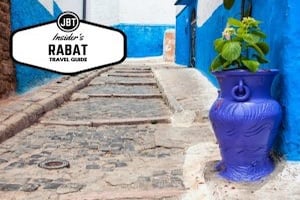If you’re in a tourist-spinning tizzy, and inclined to get away from Fez, take a day trip southwest of Taza to Jbel Tazzeka National Park where unwonted natural solitude abounds. Here, you can pose next to the Cascades de Ras el-Oued waterfall, visit the Daia Chiker lake bed, explore the Gouffre du Friouato caverns and revere at the Oued Zireg gorges. This atypical wonderment centered in the Middle Atlas Mountains near Mgoun offers sightseers, campers, hikers and outdoor-lovers alike a chance to slip away into Morocco’s own Mother Earth.
Getting to Jbel Tazzeka National Park can be difficult, but if you pre-plan, you can bask in the unrefined splendor of nature in no time. Since there is no public transport, the best way to reach Tazzeka is by renting a car for a day or two from Fez. If it’s too late or not possible, then gather some friends together and hire a grand taxi (plus driver) for the day. The cost is varying, so keep up with your bargaining French or Arabic to get the best deal. If you drive yourself, from Taza take road S311, 47 miles southwest. The road, though seldom used, is narrow but well sealed. Drive with care as other drivers and taxis steer higgledy-piggledy.
Before entering the park, you’ll want to turn left towards the Ras el-Mar or headwaters to the Cascades de Ras el-Oued. Though ambushing chutes of water spill during the winter, the summer dry spells leave this waterfall a bit of a rivulet. However, if you have the time and want to see it for pictures-sake anyway, it’s well worth the small detour before entering the park proper.
Jbel Tazzeka National Park is used to seeing its fair share of tourists, but in limited quantities at limited times. So, most likely you’ll be the only one delighting in the picnic areas, walking paths, eco-museum and camping sites. Save setting camp for later, as you head to Daia Chiker.
Daia Chiker is a prodigious dry lake bed, circumscribed with cedar and coniferous growth. During most of the year, locals use it for grazing animals and growing crops, but geologists and tourists use it to view its uncommon fault lines and calciferous rock structures. The lake bed itself is connected to subterranean reservoir, which changes the state of the upper lakebed dramatically at different times of the year. Sometimes, during the rainier months, a small lake forms in the hub of the dry lake bed.
The Gouffre du Friouato was first explored in 1935 but to this day the end has never fully been reached. A vast cavern nose-diving vertically for over 100 meters, the Gouffre du Friouato breaks off into various chambers below. Take your own flashlight, as over 700 steps with handrails follows to the bottom where you can survey stalactites in various chambers till your hearts content. The guardian, Mostapha, can provide guided tours, but self-exploration is quite common and possible. If you don’t surface after some time, don’t distress, as Mostapha knows the caves better than anyone else.
Jbel Tazzeka has an altitude of 6, 498 feet (1,980 meters). After hiking or trekking Morocco up to the summit, it’s possible to see the Rif Mountains undulating to the north, the Middle Atlas’s smaller peaks reaching to the south, the flatlands of Fez careening to the west and snowcapped Jbel Boulblane to the east. Established as a national treasure in 1950, Jbel Tazzeka National Park brims with beauty and grandeur and awaits travelers who want to see another side of exotic Morocco.







